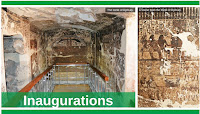Monday, July 11, 2016
Ancient Egypt this week: Games, Videos, and the Ministry of Antiquities
Childbirth stelae picked as Egyptian Museum's July piece of the month in online vote
The foyer of the Egyptian Museum in Tahrir will be graced with the newly-picked July piece of the month; a Ptolemaic childbirth stelae that won a Facebook poll put up by the antiquities ministry.
The stelae is carved in limestone and depicts the childbirth process, showing a Ptolemaic woman giving birth with the help of two ancient Egyptian deities sitting beside her.
Ministry of Antiquities newsletter
The 1st issue of the Ministry of Antiquities’ new monthly Newsletter is out.
It is in both English and Arabic.
Curator’s diary July 2016: Egyptomania at Biddulph Grange
Yesterday several curators from Manchester Museum had the pleasure of visiting Biddulph Grange, a National Trust property in north Staffordshire. We are particularly interested in exploring the theme of migration – of people, objects and ideas – and in ways of capturing the connections. Biddulph Grange represents a wonderful example of multi-cultural influences in the later Nineteenth Century that stretches across traditionally separate areas of Botany, Geology and Egyptology.
A relief of King Nectanebo II recovered to Egypt from Paris
Egypt's antiquities ministry succeeded in recovering the stolen relief of King Nectanebo II of the 30th dynasty that was smuggled out of Egypt over a decade ago.
Shaaban Abdel-Gawad, the supervisor-general of the Antiquities Recuperation Department, told Ahram Online that the object was stolen from a temple in the Saqqara necropolis during the 1990s.
Why did ancient Egypt spend 3000 years playing a game (Senet) nobody else liked?
It was hard work being dead in ancient Egypt. You had to put the hours in. Upon death, ancient Egyptians believed that your ba - soul is the closest word we have - was kicked loose from your body and freed to roam the lands. This freedom came with limitations, however. Every day your ba left the tomb where your mummy rested and wandered in the heavens. Every night, it had to work its way back home, descending with the sun god to the world of the dead and undergoing great trials, before it finally rejoined the body in an act of supreme spiritual renewal. As above, so below: the Egyptians believed that the sun was born every morning and died every evening. The ba mimicked its journey through the sky.
The importance of death in everyday Egyptian life
Often, exhibitions of ancient Egyptian artefacts divide their galleries into objects of ‘daily life’ and those associated with ‘burial and the afterlife’, despite most of the objects deriving from the excavation of burials, and the majority of these having been used in life. The Egyptians themselves would probably have been bemused by this division; to them, death was a transition to a different state of being, where life continued. True death only occurred following the judgement by Osiris, king of the blessed dead, when a person could be sentenced to obliteration. To some degree then, preparation for death was a bit like considering what to pack for a move abroad; many of the items used in life would be just as useful in the beyond.
Nile Cruise in 1964
This is an odd little video made right before the Aswan High Dam was built. The narrator cheerfully concludes that many temples and monument will go underwater, but it's ok because we've already recorded everything we need to know. One monument he has a bit of remorse about is Abu Simbel, but then concludes its fate was sealed. Which as we know, it thankfully was not. A rare glimpse into the mid-twentieth century.
UNSEEN EGYPT: LANTERN SLIDES PLACES
Somewhere along the way, and a few thousand years, monuments such as Karnak fell into disrepair. Between the ever relentless sands of the desert reclaiming its territory, the Nile’s inundation, and the passage of time, they almost faded out of memory. Every now and then through the millenia, travellers and explorers would stumble upon an obelisk here, or statue there, and if they were persistant and lucky enough, maybe a pylon and gate into a mysterious past.
Egyptian Gods and the Devourer
Horrible Histories - Egyptian Gods and The Devourer - YouTube from Ellen Warburton on Vimeo.
Subscribe to:
Post Comments (Atom)









No comments:
Post a Comment
Note: Only a member of this blog may post a comment.